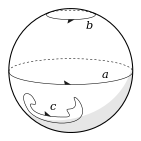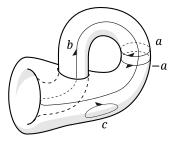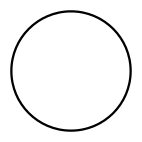
A | B | C | D | E | F | G | H | CH | I | J | K | L | M | N | O | P | Q | R | S | T | U | V | W | X | Y | Z | 0 | 1 | 2 | 3 | 4 | 5 | 6 | 7 | 8 | 9
In mathematics, homology[a] is a general way of associating a sequence of algebraic objects, such as abelian groups or modules, with other mathematical objects such as topological spaces. Homology groups were originally defined in algebraic topology. Similar constructions are available in a wide variety of other contexts, such as abstract algebra, groups, Lie algebras, Galois theory, and algebraic geometry.
The original motivation for defining homology groups was the observation that two shapes can be distinguished by examining their holes. For instance, a circle is not a disk because the circle has a hole through it while the disk is solid, and the ordinary sphere is not a circle because the sphere encloses a two-dimensional hole while the circle encloses a one-dimensional hole. However, because a hole is "not there", it is not immediately obvious how to define a hole or how to distinguish different kinds of holes. Homology was originally a rigorous mathematical method for defining and categorizing holes in a manifold. Loosely speaking, a cycle is a closed submanifold, a boundary is a cycle which is also the boundary of a submanifold, and a homology class (which represents a hole) is an equivalence class of cycles modulo boundaries. A homology class is thus represented by a cycle which is not the boundary of any submanifold: the cycle represents a hole, namely a hypothetical manifold whose boundary would be that cycle, but which is "not there".
There are many different homology theories. A particular type of mathematical object, such as a topological space or a group, may have one or more associated homology theories. When the underlying object has a geometric interpretation as topological spaces do, the nth homology group represents behavior in dimension n. Most homology groups or modules may be formulated as derived functors on appropriate abelian categories, measuring the failure of a functor to be exact. From this abstract perspective, homology groups are determined by objects of a derived category.
Background
Origins
Homology theory can be said to start with the Euler polyhedron formula, or Euler characteristic.[1] This was followed by Riemann's definition of genus and n-fold connectedness numerical invariants in 1857 and Betti's proof in 1871 of the independence of "homology numbers" from the choice of basis.[2]
Homology itself was developed as a way to analyse and classify manifolds according to their cycles – closed loops (or more generally submanifolds) that can be drawn on a given n dimensional manifold but not continuously deformed into each other.[3] These cycles are also sometimes thought of as cuts which can be glued back together, or as zippers which can be fastened and unfastened. Cycles are classified by dimension. For example, a line drawn on a surface represents a 1-cycle, a closed loop or (1-manifold), while a surface cut through a three-dimensional manifold is a 2-cycle.
Surfaces
bottle
On the ordinary sphere , the cycle b in the diagram can be shrunk to the pole, and even the equatorial great circle a can be shrunk in the same way. The Jordan curve theorem shows that any arbitrary cycle such as c can be similarly shrunk to a point. All cycles on the sphere can therefore be continuously transformed into each other and belong to the same homology class. They are said to be homologous to zero. Cutting a manifold along a cycle homologous to zero separates the manifold into two or more components. For example, cutting the sphere along a produces two hemispheres.
This is not generally true of cycles on other surfaces. The torus has cycles which cannot be continuously deformed into each other, for example in the diagram none of the cycles a, b or c can be deformed into one another. In particular, cycles a and b cannot be shrunk to a point whereas cycle c can, thus making it homologous to zero.
If the torus surface is cut along both a and b, it can be opened out and flattened into a rectangle or, more conveniently, a square. One opposite pair of sides represents the cut along a, and the other opposite pair represents the cut along b.
The edges of the square may then be glued back together in different ways. The square can be twisted to allow edges to meet in the opposite direction, as shown by the arrows in the diagram. The various ways of gluing the sides yield just four topologically distinct surfaces:

is the Klein bottle, which is a torus with a twist in it (In the square diagram, the twist can be seen as the reversal of the bottom arrow). It is a theorem that the re-glued surface must self-intersect (when immersed in Euclidean 3-space). Like the torus, cycles a and b cannot be shrunk while c can be. But unlike the torus, following b forwards right round and back reverses left and right, because b happens to cross over the twist given to one join. If an equidistant cut on one side of b is made, it returns on the other side and goes round the surface a second time before returning to its starting point, cutting out a twisted Möbius strip. Because local left and right can be arbitrarily re-oriented in this way, the surface as a whole is said to be non-orientable.
The projective plane has both joins twisted. The uncut form, generally represented as the Boy surface, is visually complex, so a hemispherical embedding is shown in the diagram, in which antipodal points around the rim such as A and A′ are identified as the same point. Again, a is non-shrinkable while c is. If b were only wound once, it would also be non-shrinkable and reverse left and right. However it is wound a second time, which swaps right and left back again; it can be shrunk to a point and is homologous to c.
Cycles can be joined or added together, as a and b on the torus were when it was cut open and flattened down. In the Klein bottle diagram, a goes round one way and −a goes round the opposite way. If a is thought of as a cut, then −a can be thought of as a gluing operation. Making a cut and then re-gluing it does not change the surface, so a + (−a) = 0.
But now consider two a-cycles. Since the Klein bottle is nonorientable, you can transport one of them all the way round the bottle (along the b-cycle), and it will come back as −a. This is because the Klein bottle is made from a cylinder, whose a-cycle ends are glued together with opposite orientations. Hence 2a = a + a = a + (−a) = 0. This phenomenon is called torsion. Similarly, in the projective plane, following the unshrinkable cycle b round twice remarkably creates a trivial cycle which can be shrunk to a point; that is, b + b = 0. Because b must be followed around twice to achieve a zero cycle, the surface is said to have a torsion coefficient of 2. However, following a b-cycle around twice in the Klein bottle gives simply b + b = 2b, since this cycle lives in a torsion-free homology class. This corresponds to the fact that in the fundamental polygon of the Klein bottle, only one pair of sides is glued with a twist, whereas in the projective plane both sides are twisted.
A square is a contractible topological space, which implies that it has trivial homology. Consequently, additional cuts disconnect it. The square is not the only shape in the plane that can be glued into a surface. Gluing opposite sides of an octagon, for example, produces a surface with two holes. In fact, all closed surfaces can be produced by gluing the sides of some polygon and all even-sided polygons (2n-gons) can be glued to make different manifolds. Conversely, a closed surface with n non-zero classes can be cut into a 2n-gon. Variations are also possible, for example a hexagon may also be glued to form a torus.[4]
The first recognisable theory of homology was published by Henri Poincaré in his seminal paper "Analysis situs", J. Ecole polytech. (2) 1. 1–121 (1895). The paper introduced homology classes and relations. The possible configurations of orientable cycles are classified by the Betti numbers of the manifold (Betti numbers are a refinement of the Euler characteristic). Classifying the non-orientable cycles requires additional information about torsion coefficients.[3]
The complete classification of 1- and 2-manifolds is given in the table.
| Manifold | Euler no., χ |
Orientability | Betti numbers | Torsion coefficient (1-dimensional) | |||
|---|---|---|---|---|---|---|---|
| Symbol[4] | Name | b0 | b1 | b2 | |||
| Circle (1-manifold) | 0 | Orientable | 1 | 1 | — | — | |
| Sphere | 2 | Orientable | 1 | 0 | 1 | None | |
| Torus | 0 | Orientable | 1 | 2 | 1 | None | |
| Projective plane | 1 | Non-orientable | 1 | 0 | 0 | 2 | |
| Klein bottle | 0 | Non-orientable | 1 | 1 | 0 | 2 | |
| 2-holed torus | −2 | Orientable | 1 | 4 | 1 | None | |
| g-holed torus (g is the genus) | 2 − 2g | Orientable | 1 | 2g | 1 | None | |
| Sphere with c cross-caps | 2 − c | Non-orientable | 1 | c − 1 | 0 | 2 | |
| 2-Manifold with g holes and c cross-caps (c > 0) | 2 − (2g + c) | Non-orientable | 1 | (2g + c) − 1 | 0 | 2 | |
- Notes
- For a non-orientable surface, a hole is equivalent to two cross-caps.
- Any 2-manifold is the connected sum of g tori and c projective planes. For the sphere , g = c = 0.
Generalization
A manifold with boundary or open manifold is topologically distinct from a closed manifold and can be created by making a cut in any suitable closed manifold. For example the disk or 2-ball is bounded by a circle .[citation needed] It may be created by cutting a trivial cycle in any 2-manifold and keeping the piece removed, by piercing the sphere and stretching the puncture wide, or by cutting the projective plane. It can also be seen as filling-in the circle in the plane.
When two cycles can be continuously deformed into each other, then cutting along one produces the same shape as cutting along the other, up to some bending and stretching. In this case the two cycles are said to be homologous or to lie in the same homology class. Additionally, if one cycle can be continuously deformed into a combination of other cycles, then cutting along the initial cycle is the same as cutting along the combination of other cycles. For example, cutting along a figure 8 is equivalent to cutting along its two lobes. In this case, the figure 8 is said to be homologous to the sum of its lobes.
Two open manifolds with similar boundaries (up to some bending and stretching) may be glued together to form a new manifold which is their connected sum.
This geometric analysis of manifolds is not rigorous. In a search for increased rigour, Poincaré went on to develop the simplicial homology of a triangulated manifold and to create what is now called a chain complex.[6][7] These chain complexes (since greatly generalized) form the basis for most modern treatments of homology.
In such treatments a cycle need not be continuous: a 0-cycle is a set of points, and cutting along this cycle corresponds to puncturing the manifold. A 1-cycle corresponds to a set of closed loops (an image of the 1-manifold ). On a surface, cutting along a 1-cycle yields either disconnected pieces or a simpler shape. A 2-cycle corresponds to a collection of embedded surfaces such as a sphere or a torus, and so on.
Emmy Noether and, independently, Leopold Vietoris and Walther Mayer further developed the theory of algebraic homology groups in the period 1925–28.[8][9][10] The new combinatorial topology formally treated topological classes as abelian groups. Homology groups are finitely generated abelian groups, and homology classes are elements of these groups. The Betti numbers of the manifold are the rank of the free part of the homology group, and the non-orientable cycles are described by the torsion part.
The subsequent spread of homology groups brought a change of terminology and viewpoint from "combinatorial topology" to "algebraic topology".[11] Algebraic homology remains the primary method of classifying manifolds.[12]
Informal examples
The homology of a topological space X is a set of topological invariants of X represented by its homology groups
A one-dimensional sphere is a circle. It has a single connected component and a one-dimensional-boundary hole, but no higher-dimensional holes. The corresponding homology groups are given as
Antropológia
Aplikované vedy
Bibliometria
Dejiny vedy
Encyklopédie
Filozofia vedy
Forenzné vedy
Humanitné vedy
Knižničná veda
Kryogenika
Kryptológia
Kulturológia
Literárna veda
Medzidisciplinárne oblasti
Metódy kvantitatívnej analýzy
Metavedy
Metodika
Text je dostupný za podmienok Creative
Commons Attribution/Share-Alike License 3.0 Unported; prípadne za ďalších
podmienok.
Podrobnejšie informácie nájdete na stránke Podmienky
použitia.
www.astronomia.sk | www.biologia.sk | www.botanika.sk | www.dejiny.sk | www.economy.sk | www.elektrotechnika.sk | www.estetika.sk | www.farmakologia.sk | www.filozofia.sk | Fyzika | www.futurologia.sk | www.genetika.sk | www.chemia.sk | www.lingvistika.sk | www.politologia.sk | www.psychologia.sk | www.sexuologia.sk | www.sociologia.sk | www.veda.sk I www.zoologia.sk



















